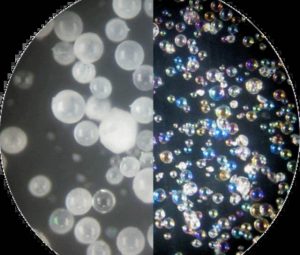The physical characteristics of HG hollow glass microspheres lead to the following advantages:
1. The alkali lime borosilicate component of the glass microsphere makes its chemical property stable and inert, so that it can be safely used as a filler or additive without worrying about its reaction with the substrate or other substances, and can withstand other chemical corrosion except strong alkali.
2. The perfect sphericity endows it with excellent isotropic consistency, so that it will not warp and shrink due to stress inconsistency after processing.
3. The hollow glass microsphere is a small round ball. In the liquid, it acts like a miniature ball bearing, and has better fluidity than the fillings of sheet, needle or irregular shape. The resulting microsphere effect reduces the viscosity of the mixture, and the filling performance is naturally excellent; Good processing performance can improve the production efficiency by 10%~20%.
4. The perfect sphericity makes it have a small specific surface area of Z, so its oil absorption is low. Compared with the conventional filler calcium carbonate, the oil absorption rate/amount of hollow glass microspheres is much lower. The oil absorption rate of different models of products per 100g is between 7 and 40mg, while the oil absorption rate of light calcium carbonate per 100g is as high as 120 to 130mg, and that of heavy calcium carbonate is as high as 50 to 60mg. The amount of resin is reduced. At the same time, because it can increase the fluidity of resin, the resin is processed only as a base material rather than a filler, thus reducing the amount of resin.
5. Due to the particle size distribution of glass microspheres, small microspheres fill the pores of large microspheres, thus increasing their solid content. At the same time, their volatilization is very low, which reduces VOC
6. The color is white, so it has good color compatibility.
7. Its low true density and strong compressive strength result in its high compressive strength density ratio, which makes it not only play the role of filler or additive with reduced density, but also have a good survival rate and stability in the processing process in some applications requiring high compressive strength, such as extrusion, die or petroleum industry
8. The particle size is small, which will not reduce its toughness when mixed with resin for processing.
9: The interior of the hollow glass microsphere is a vacuum thin gas. Two different materials have different densities and thermal conductivity, so it has the characteristics of sound insulation, heat insulation and low thermal conductivity. It is an excellent filler for various heat insulation and sound insulation products. The thermal insulation properties of the microspheres can also be used to protect the products from thermal shock caused by alternate changes between hot and cold conditions
10: The closed space ratio is very high. At the same time, the sphere is tight and perfect, and it is insoluble in water, which makes its application in water very stable. Water will not enter the interior of the sphere, so it does not cause the problem of density increase. At the same time, because it is insoluble in water, its application in water, such as yachts, rowing, etc., is also extremely stable.
11: Some tests have shown that hollow or low hardness fillers will absorb and digest the impact strength when impacted, so as to improve the impact resistance of materials. Therefore, as a filler, it can improve the physical and mechanical properties of plastic products. At the same time, the hardness and elastic modulus of the material can be greatly increased, and the stiffness and stress damping capacity can also be improved.
12: It can maintain its stability below 600 ℃, so it is stable in some applications requiring slightly higher temperature.
